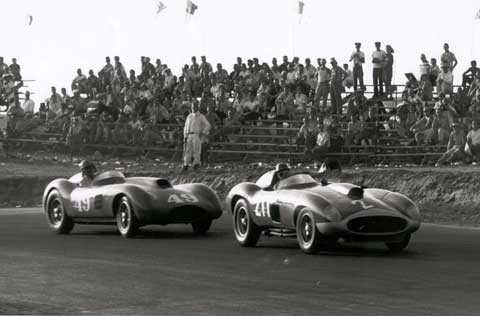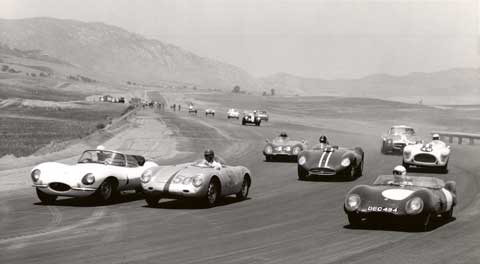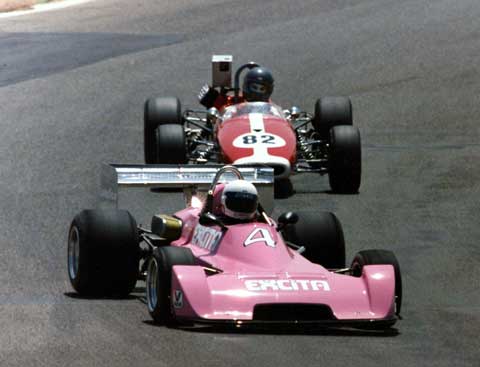
Riverside’s first feature event, September 22, 1957. Eventual winner Richie Ginther, in John Edgar’s Ferrari 410S leads Bob Drake in Frank Arciero’s Ferrari 375 Plus early in the race.
Credit: Ken Parker, MTL Archive.
By Michael T. Lynch
When road racing enjoyed a revival after World War II, Watkins Glen, New York held the first race in the fall of 1948. The next year, Bridgehampton, New York; Linden, New Jersey; Concord, California and Ft. Lauderdale, Florida joined Watkins Glen with races for the imported cars that were arriving on U.S. shores.
These races were run on public roads or airport circuits. It took years for the sport to progress to the point that investors could be found to finance purpose-built circuits. Southern California was a hotbed of sports car racing and early courses were built at Willow Springs (1953) and Paramount Ranch (Agoura, in 1956).
At the time, Los Angeles was the country’s citadel of speed. Every Indianapolis 500 winner since 1941 had been built in various shops there and other racing disciplines like drag racing had originated in the City of Angels. It was almost unthinkable that the area did not have a permanent road circuit. By 1957, investors felt confident that road racing would survive and prosper, and that year saw an explosion of new permanent courses nationwide including Bridgehampton, Lime Rock CT, Virginia International Raceway and two California courses, Laguna Seca and Riverside.
The latter, near the unincorporated hamlet of Edgemont in Riverside County, was the brainchild of a Swiss restaurateur, Rudy Cleye. Cleye was an early road racer, competing in a Mercedes 300SL. His establishment, The Blarney Castle, was a hangout for the sports car crowd and many a night was spent by the regulars at the bar bemoaning the fact that Southern California didn’t have a permanent course in keeping with the Southland’s racing heritage. Cleye put together an investment group, which included a fellow racer, James E. Peterson, the course’s designer and contractor. Construction commenced early in 1957.
As the year wore on, Cleye’s group was running out of funds. They enlisted John Edgar, a local entrant, whose drivers included Carroll Shelby, to make up the shortfall. Edgar financed the venture with $500,000, a substantial amount of money in 1957 for such a risky project. As a result, the course was completed and Riverside staged its first races over the weekend of September 21-22, 1957.
The race was a California Sports Car Club regional event, since the Sports Car Club of America would not sanction a National until the track had run at least one race. In retrospect, this was an unusual situation. The Cal Club was the SCCA’s only substantial rival as a road racing sanctioning body. Southern California road racing was dominated by Cal Club events, as opposed to the rest of the country where the SCCA was the primary sanctioning body. After months of negotiations, the Cal Club offered a more advantageous split of gate proceeds with the track organizers, so the first event carried their sanction.
The weekend began with an accident involving one of the favorites. On the first lap of practice, Carroll Shelby crashed John Edgar’s Maserati 450S, the car in which the great Juan Manuel Fangio had won Sebring earlier in the year. Shelby was taken to a local hospital where a plastic surgeon was luckily on duty. It took 72 stitches to sew Shel up and while the doctor worked, he referred to an 8 X 10 glossy promotional picture of Shelby.
The next day’s racing saw three winners get the bulk of the attention. In the big production car race, a local boy, Dan Gurney, won in Cal Bailey’s Corvette. It was the biggest win of his short career. In the small car feature, an unknown 15-year-old from Mexico, Ricardo Rodriguez, won in a Porsche 550, beating all the American veterans. It was his first American race and he would ultimately progress to the Grand Prix circuits of Europe and death at twenty in a Lotus at his home track in Mexico City.
With Shelby out, the one-hour big car feature was wide open. Chuck Daigh led in the Troutman-Barnes Special until he blew a tire. Bob Drake, perhaps the most underrated driver of the era, took over in Frank Arciero’s Ferrari 375 Plus. With only two laps to go, Drake ran wide at turn one, handing the victory to Richie Ginther in John Edgar’s Ferrari 410 Sport. Years later, Edgar would say that the victory was his favorite because it came on the heels of his worry about Shelby’s crash and his pride in making sure the track got finished. The weekend was an almost unqualified success and the crowds filed out thinking of the coming SCCA National, set for November 16-17.
SCCA National races were the highest form of road racing in the States at the time except for rare International events like Sebring. The turnout for Riverside included Masten Gregory and Carroll Shelby in Temple Buell and John Edgar’s Maserati 450Ss, Eastern top gun Walt Hansgen in a Briggs Cunningham D-Jaguar, Paul O’Shea in a special Mercedes 300 SL roadster that ran in the modified class, as well as the usual West Coast favorites like John von Neumann and Richie Ginther in Ferraris.
Unseasonably cold weather held the crowd to 20,000, but those who showed up saw a barnburner. There were ten races over the weekend, with Saturday’s short sprints determining Sunday starting positions. On Sunday, Jack McAfee won the under-1500cc semi-main in Stan Sugarman’s Porsche 550.
When the flag went down for the 25-lap feature over the 3.2-mile course, four cars muscled each other for position in the first few turns. Hansgen led Gregory and Shelby with a fourth car close behind that wasn’t in the program. It turned out to be Dan Gurney in Arciero’s 375 Plus Ferrari, the car that had almost won the opening event. Arciero had waited until the last minute to replace Bob Drake in the car and the decision was made long after the program went to press. Nonetheless, the cognoscenti in the crowd soon spread the word that Gurney, who lived in Riverside, was running with the big dogs in his first race in something other than a production car.
Hansgen passed Gregory, as did Shelby on lap three. Shelby took the lead on lap four, only to run off on the next lap, dropping to sixth. With the crowd pressing the snow fence, Shelby began a march through the field. Fifth on lap seven, fourth on lap 11, third on lap 14 and second behind Gurney on lap 15. On the 17th lap, Shelby shot into the lead, which he retained until the end, with Gurney finishing second, 5 seconds behind. Gregory was third. That 1957 autumn was the beginning of great racing, spectacular fields and close finishes at Riverside. Relief probably tempered Edgar’s pride in his contribution to the success of the track when the property changed hands in 1960. Edgar got his investment out intact.

This rare photo was taken at a press day before the opening of Riverside International Raceway. The cars are not racing but providing a photo op. The setting is at the end of the 1.1 mile straight and the cars are entering the notorious turn nine. The white Jaguar XKSS in the left is driven by James E. Peterson, a racer who was both contractor and designer of the course. Other notables of the day include Ken Miles in John von Neumann’s Porsche 550 (#50) and Jay Chamberlain’s Lotus XI. Dan Gurney is in Tony Parravano’s Maserati 450S (car with stripe behind Miles). Note the lack of any facilities in this view. Credit: Lester Nehamkin, MTL Archive
Less than a month after his second at Riverside, Gurney would use Arciero’s Ferrari to win his first feature race, at Paramount Ranch. At this point, Dan only had 15 races behind him. Because he was the hometown boy and posted so many victories in years to come at Riverside, some refer to it as The House that Gurney Built, paraphrasing the comment about Babe Ruth and Yankee Stadium.
In keeping with the diversity of racing in the area, Riverside would host every major series at one time or another, including a World Championship Grand Prix in 1960. Other forms of racing included Can Am, USAC sports cars, stock cars and Champ cars, IMSA, Trans Am, NASCAR, IROC races, including the first of that series, Formula 5000, Drag Racing, Off Road Racing and motorcycle racing under several sanctioning bodies. There were two different oval layouts over time. Perhaps the weirdest event there took place over Memorial Day weekend, 1958. The card had three 500-mile races – after all, they were racing 500 miles in Indianapolis that weekend. At Riverside, the races weren’t for Champ cars, but sprints, midgets and stock cars, the long distance previously unknown to the midgets and sprints.
As the track matured, Gurney was instrumental in establishing NASCAR, then a primarily regional series, in the West. In 1963, Dan won the Motor Trend 500 NASCAR race in front of 10,000 people. He went on to win the same race in 1964-5-6. When he won it for the fifth and final time in 1968, there were 100,000 fans on the property to see their local favorite see off the good ol’ boys.
Dan is also well known as a driver and constructor of Indy cars, and he combined both talents to win the Rex Mays 300 USAC races at Riverside in 1967 and 1968.

After many races that were billed as the last at Riverside, the end finally came on July 17, 1989. Here, Philippe de Lespinay in his ex-Keke Rosberg Chevron B34 leads a Brabham through Turn 7. Credit: Philippe de Lespinay Collection.
As the years passed, encroaching development made it hard to justify the property’s use for racing. The returns were not commensurate with the value of the property for development. The conventional wisdom is that the last race was a Cal Club event over the weekend of July 2-3, 1989, but Philippe de Lespinay has dated pictures of himself in his Chevron B34 at a VARA vintage car race held over the weekend of July 16-17 of that year. It was the final sanctioned event. Today, remnants of the track can barely be seen. One of the developments on the property has streets named for Mario Andretti, Mark Donohue, Dan Gurney, Roger Penske, John Surtees and Cale Yarborough.
Thousands of drivers, mechanics, journalists, car owners, celebrities and just plain fans had enjoyed the racing over the years and coveted their memories of their times at the track. Several years ago, Richard Holub began an international Internet plea to build a memorial site in the area. Sadly, little was accomplished except for a small display of pictures and artifacts in the Moreno Valley Community Center.
Doug Magnon and his father Ray, long time area residents, also had ambitions of preserving Riverside’s heritage. In 2005, they built a two story building in an industrial area which houses a fabulous car collection, including cars that raced at Riverside, as well as memorabilia from both Riverside and Ontario Motor Speedway, another major SoCal track that ceased operations in 1980. The Magnons’ Riverside International Automotive Museum will present the Legends of Riverside Gala and Film Festival on March 27th through 29th. Events include panels, an automotive art exhibition, a film festival, awards, banquets and much more. More than 50 of the greatest drivers in Riverside history will be present including Dan Gurney. The event will benefit the Parkinson’s Institute, the Lee Iacocca Foundation, Hole in the Wall Camps and the California Highway Patrol 11-99 Foundation. For ticket and schedule information, go to http://www.legendsofriverside.com or call 951 369-6966.
Riverside International Raceway may be gone, but thanks to the Magnons and thousands of others who remember the track’s great heritage, it will not be forgotten.
i watched the lockbourne (OH) sac races in 1956, also the pebble beach (CA) races that year.
1957 was my first of many visits to thompson (CT).
you already know about my 2 visits to riverside.
> jack
Great job, Michael. But about that World Championship Grand Prix in 1959. Do the folks at Sebring know about that?
Woody
Woody,
The year was 1960, and we’ve corrected the text.
Pete
Michael, great story. I LOVED Riverside and won many motorcycle races there. I have so many great memories of the place, both with cars and bikes… Those esses are engraved in my brain cells til my death, hopefully of old age.
I was at a USAC race–faded in memory–where only 3 cars were running at the finish. The announcer was having fun commenting on the weather and suchlike until he’d surprisingly hear a car….when was that?
Philppe de Lespinay is very probably correct with his July 16/17th 1989 being the last sanctioned race at Riverside. I wonder if he won the race? If not,then who?
Larry Pond sent me a magnificant but bogus (made up) trophy for our co-drive to First in Class in a Shelby GT 350. Anyone know if records exist ? We sure had a terrific time. When not drifting through the esses, and sliding out on to the back strait from turn 7A, it was the one and only time I also announced the race! Jeeze, what a Vintage day!
We were there for the last Riverside SCCA race running our ITB Pinto (July 2-4 1989) Still have a ticket stub. cars came out of the woodwork! Boy we sure miss the place… Great story thanks!!! Glenn
Another great article, Mike. You are the best when it comes to chronicling the heyday of racing on the west coast.
One of my best memories of Riverside was the 1959 LA Times Grand Prix. All of the big names and great cars were there. It was the first major race that I attended having recently moved from the midwest. I saw and heard the great Ferraris of the day for the first time and was hooked for good.
My saddest memory of Riverside is the day the track ceased to exist.
I recently discovered this site via an Alfa vintage racer friend…. Like Philippe… I too raced bikes (250gp) at Riverside and have great memories of turn 1 (all three levels of it), turn 9 (the exit was a rush), the esses and super straight per the long course. I can see in my mind this minute 900 Kawasakis going thru turn one and all the swing arm flex… And Robert’s run away wins, and Steve Baker, and, and, etc. I also see Anatoly’s comments. Turns out the ’64 Morgan +4 I’ve been racing for the last 10 years won the national e prod championship in ’66 with a win at Riverside at the hands of Carl Swanson. I’m really glad to discover VeloceToday and sending the link around. I live in Monterey and am calling tomorrow to get details on the Quail event in May… All the best, doug
In May of 1990, Paul Pfanner (of RACER magazine) and myself drove out to Riverside on its last day of operation, which was a Skip Barber Racing School class. Much of the track had been plowed up and temporary sections had been paved to allow the school to make complete laps of the course that remained. Condos had sprung up within close view of the old straight. It was so sad. We lapped the course with one of the instructors. I shot many photos and we went over to Turn 6 (with the wall gone and the blacktop scraped into a pile) and I thought it was a great opportunity to collect pieces of the track as momentos. We looked around and found a cardboard box and loaded it up with hunks of Turn 6. Paul distributed them among the staff at RACER, and I have mine propped on a bookshelf in my office. I raced motorcycles and Formula Fords there and spectated at many of the races and very much miss RIR to this day.
D. Randy Riggs
Vintage Motorsport
If you don’t have it, Michael’s /American Sports Car Racing In The 1950s/ is worth seeking. Seems as if his book site is gone, now, but there may be copies out there, at premium prices.
There may be some material you haven’t seen, on my pages at:
http://home.roadrunner.com/~fsheff/rirpicts.htm
See you at the Legends of Riverside, end of the month-ish?
/¡VIVA RIR!/